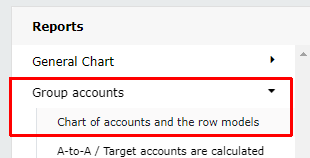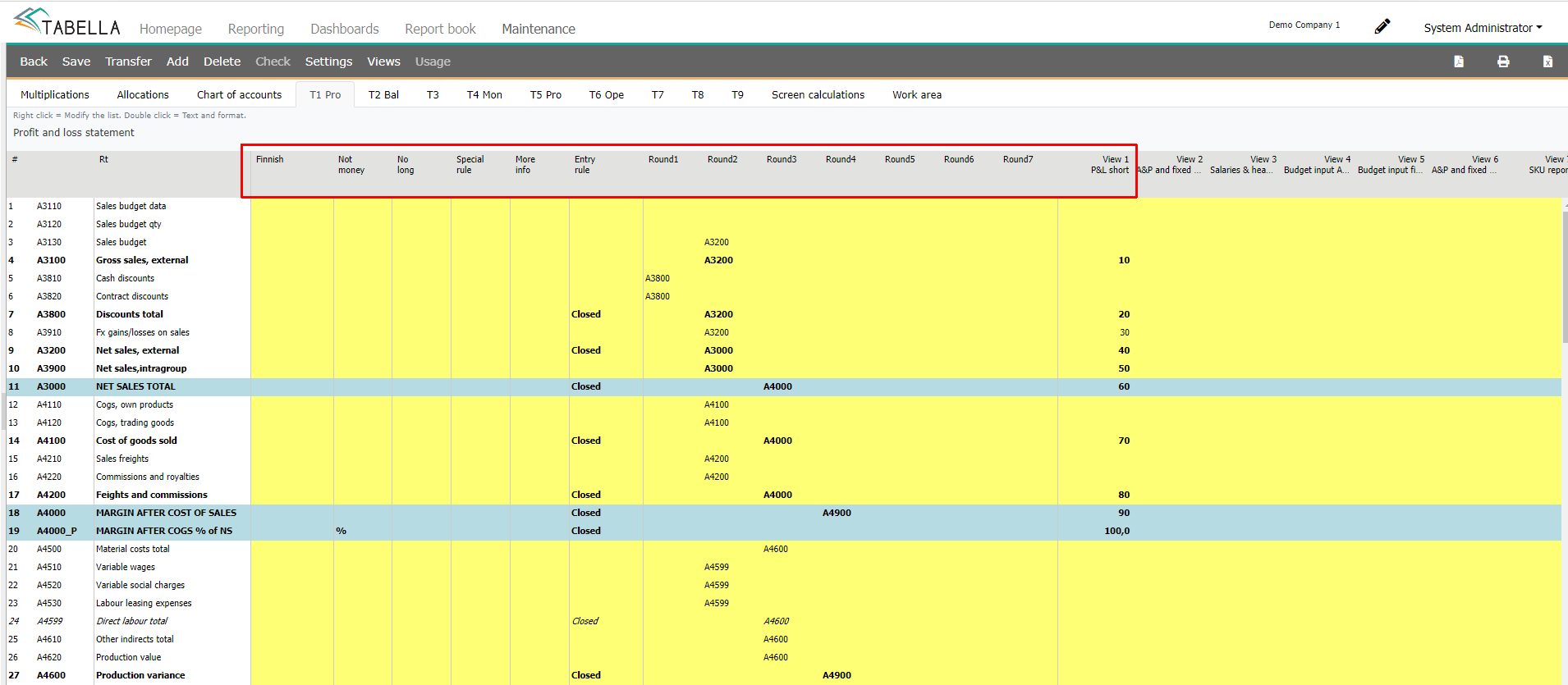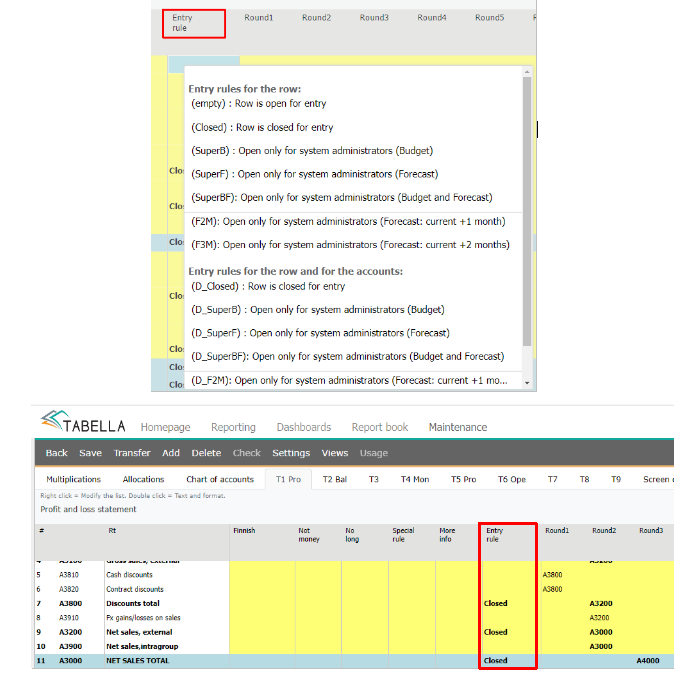Chart of accounts and row model maintenance
All Tabella row models are generated by steering account rows from the chart of accounts to row models’ sum rows. From these rows, by using Round steerings, the desired row model is created, for example balance sheet. Row models are formed separately for each chart of accounts in use.
In addition to row models, allocations and multiplications are also defined in the chart of account maintenance.
The maximum number of chart of accounts is nine (9).
Select chart of accounts.

Maintain
chart of accounts -add / delete / modify accounts, and steer accounts to row models sum rows.
row models -add / delete / modify row models, texts and define calculation rules.
Tabs

Multiplications – the purpose is to produce new rows in to the chart of accounts, based for instance, on price and quantities sold. The tab can be opened at List of codeplans maintenance, by marking the option Multiplications in use.
Allocations -the purpose is to transfer data from one unit to another. The tab can be opened at List of codeplans maintenance, by marking the option Allocations in use.
Chart of accounts -list of the accounts: account numbers/texts and their steerings to the row models’ sum rows.
Row models – the maximum number is 35. The code names of the row models in the maintenance are T1… TK. Each model has its own tab and connection to the respective Tn-column in the chart of accounts. The number of row models in use is defined at List of codeplans maintenance.
Screen calculations - define calculation rules for the rows, which are calculated after data is being load on screen. This is done to ensure correct values also in accumulated reports.
Chart of accounts
Tilikartan tiliriveistä ohjataan tili tai tilit rivimallipohjaan perustetuille summariveille. Rivimalli muodostetaan näistä summariveistä, esimerkiksi kateraportti ns. Round ohjauksilla. Selailun Pitkässä raporttimuodossa näkyvät kaikki rivimalliin summariveille ohjatut tilit ja lyhyessä muodossa vain summarivit. Ylläpito tehdään Lyhyessä muodossa.
Note
accounts are steered to the row models sum rows. Please notice, that sum rows codes has to be unique in each row model. In the example below, the row “1859 Other accrued receivables”, is steered to several row models sum rows, and the sum row’s code is different in each: B110, C105 and D35.

In the Tabella initial installation two tabs: chart of accounts and T1 are predefined.
Next, the use of columns, both in the chart of accounts and in the row model is explained in more detail.
Columns in a chart of accounts
Use right mouse menu in a selected column to do the specification needed for the account row.
Finnish (e.g.) – it possible to use other language than default, both in the chart of accounts and in the row model. If in use, then the accounts for example, can be written in finnish. The System Admin defines languages in use. See Admnistrator settings
Not money - marking in the column defines that account’s value is not a monetary value, and therefore may not be divided or changed to another currency. For example:
kg / h / pcs / m2
These codes will be used as headers in row reports and in charts. If there is no marking, the account’s value is monetary.
Note
If the account has marking in the NotMoney column, then account’s code (account number) is not shown in the long report format in browsing.
Balance - marking 1 in this column, means that account is balance account that requires special treatment. However, the need for this is different for each company, thus the need is assessed during Tabella installation.
The purpose is to separate P/L and balance accounts, and it has an affect on how the sign is treated, when data is transferred from the bookkeeping into Tabella. Therefore, for example, if a new balance account is created, it is essential that the mark here is defined before the data is being transferred -the rule comes into force, when data is transferred to Tabella.
If the marking from the balance account is missing, mark it, and save changes. Then re-transfer data from bookkeeping, starting from the first period the account has transactions, and run the reports for the actual year in question.
-marking 2, the balance sheet is presented positive in browsing. In the entry, balance accounts are entered mainly as a plus. Balance deductions are entered as a minus, and increases as a plus. For example, liabilities opening balance is entered as plus, reductions minus, and increments plus. The selection has no effect on the stored data.
Super - if no marking: the account can normally be entered and end users will also see the account’s transactions.
-marking 1, only the System Admin has rights to enter data to the account.
notrans, end users has no entry rights to the account. Additionally, transactions are disabled.
Elim. level -if needed, use Elim. column to define at what organisational level the internal account is being eliminated. The higher the number the lower the elimination level.
For example, elimination level 1 is the group’s internal, marking 2 sub-group’s internal. The same elimination level used here, has to be marked also to the tree structure’s maintenance Elim.-column.
Special rule -column in the chart of account:
Note
Account and the row model’s sum row, into which the account is steered to, has to have the same Special rule marked. For example, it is not allowed to mark account with “Ave” marking, but leave the sum row, into which the account is steered to, empty.
No marking -the value is normal number. For example, January + February + March + May data is summed = is the first quarter.
Ave -the value is monthly average (also year total). For example, the four months are summed and divided by four.
Roll -rolling average calculated separately for each month, from the start of the year.
NoAcc -value will not be accumulated in monthly reports. The value is always shown as it is. A sum is value of the last individual month. For example, whole years value = the last month’s value.
Acc -value is always accumulated
Price -value is a price, from which the average is always calculated.
More info - column is used in custom made tailoring -in connection with Cash Flow Statement definitions.
T1…TK -row model tabs. A row model contains sum rows, which are build up using accounts steered from the list of accounts. As Default T1…T9 is shown. The System Admin is able to add more tabs, at the list of the codeplan maintenance, 35 at the most.
OB to account - Opening balance to account column is used to steer all P/L accounts to the balance account row; Previous years’s Profit/Loss (marked as balance account). Further the account is steered to a row model, Balance Sheet, for example. When balances for the next fiscal year is created, is the opening balance for the previous year’s profit/loss account created also -no manual entry is needed.
Example: P/L accounts are steered to the Profit/Loss account.


If sub-accounts in balance are used -eg. depreciation on fixed assets. Use the OB to account column, to steer sub-accounts to the main account. This will close sub-accounts to the opening balance of the main account, when the balances for the next fiscal year is created.
Example, sub-accounts are used:

Drill to account - if from the transactions, in addition to Eur (€), e.g. also hours are picked up, for example to “T-account”. It is possible to define the account to be T-account’s drill account. The account where the transactions locate.
Example
The transaction contains Eur (€) and Hours. Euros are picked up to the account 3000 and hours to the “account” T3000. For the account 3000T, account 3000 is entered into the Drill to account column. Then when moved on to transaction level from the account 3000T, the transactions under the account 3000 are displayed, where the original entries for the hours are.
Own column -to define own steerings, for example for calculation, or for other purposes.
Group account -used in Tabella GC (if in use). The account used to steer accounts from the basic company to GC accounts.

Columns in the Row model
Note
Row model is maintained in the short report format.
Example row model columns:

For the row model, use the right mouse menu, on the desired column to make the selections.
Finnish (e.g.) – it possible to use other language than default, both in the chart of accounts and in the row model. If in use, then the accounts for example, is written in finnish. The System Admin defines languages in use. See Admnistrator settings
Not money - marking in the column defines that account’s value is not a monetary value, and therefore may not be divided or changed to another currency.
kg / h / pcs / m2”
These codes will be used as headers in row reports and in charts. If there is no marking, the account’s value is monetary.
No long -no marking, accounts are shown in the long report format in report browsing.
Marking 1, accounts are not shown in the long report format in browsing. Use, for example, to hide profit/loss accounts on balance sheet. Mark the Previous year’s profit/loss account row in balance sheet.
Note
Nolong -is in force only for the first level on sum rows. I.e. for the sum rows where the accounts are steered directly. The marking is not inherited downwards to accounts, from sum of sum rows.
-marking 2, accounts are shown for the System Administrators’ and for the users, who have rights to the row model (defined in the user rights maintenance).
Special rule
Note
Account and the row model’s sum row, into which the account is steered to, has to have the same Special rule marked. For example, it is not allowed to mark account with “Ave” marking, but leave the sum row, into which the account is steered to, empty.
No marking -the value is normal number
Ave -the value is monthly average (also year total)
Roll - rolling average calculated separately for each month from the start of the year
NoAcc -value will not be accumulated in monthly reports. The value is always shown as it is. A sum is value of the last individual month. For example, whole years value = the last month’s value.
Acc -value is always accumulated
Note
If row model has mark Acc, in the Special rule column:
To update the data, run the reports.
In browsing, the choice Columns | Accumulate monthly reports, is disabled, for this row model.
Accumulation concerns sum row’s only, thus can be seen only in the short report format. Individual account is not accumulated in the long report format
Price -value is price, the average is calculated.
More info -column is used for customization. No general instructions are available.
Entry rule -the System Admin defines the entry rule for the row, or for the row and its accounts. For example closes a row for entry. If column is left empty, the row is open for entry.
Using entry rules (F2M, F3M / D_F2M, D_F3M) it is possible to allow forecast entry for row / row’s accounts, only for the system admin -for the current and next month / next 2 months. Entry rules follows computer’s own calendar, not Tabella’s own calendar, and can be utilize, for example, if data is transferred from the sales system to Tabella.
Note
After the new Tabella version has been updated, it is recommended to check, that all the necessary entry rules are still in force.

Operational columns
If in the row model Settings menu is selected, that the model uses tree structure dimensions, then additional column are added to the column set: Free unit, Free row, Free dimension and Dimension unit.
The function is explained in more detail in the chapter, Create new row model | Settings and maintenance routines.
Round1… –calculation rules, to form the row model. The calculation is conducted from top to bottom, and from left to right.
View1..View99 -defined report views. Different views from one row model with the same report run. How to define Views, see chapter Views
How to create new row model is explained next.